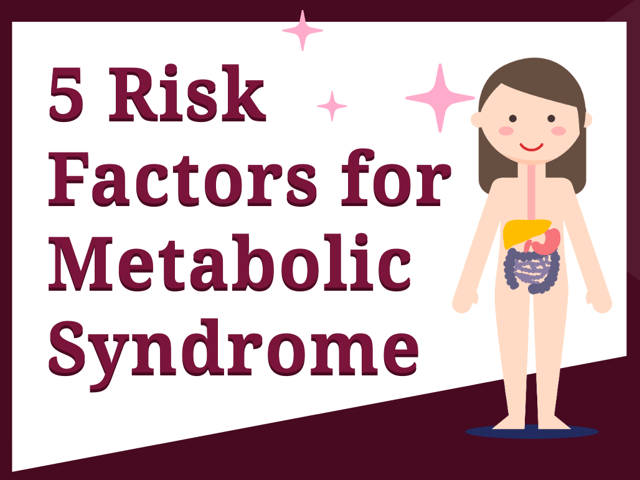
Five Risk Factors for Metabolic Syndrome
Metabolic syndrome is the cumulation of five identified factors that increase a person’s risk for cardiovascular and metabolic disease.
Research has shown that the more risk factors a person has, the greater the likelihood of that person developing heart disease, stroke, and diabetes. To diagnose or receive the diagnosis of Metabolic Syndrome, a person must exhibit at least three of the five risk factors discussed below.
1. High Fasting Blood Sugar (Insulin Resistance)
A high fasting blood sugar, also known as insulin resistance, is indicated by having a glucose level greater than or equal to 100mg/dL after fasting for 8–10 hours. A person taking medication to maintain normal glucose levels also meets the criteria for this risk factor. When insulin resistance occurs, the body is unable to properly use the insulin hormone to move blood sugar into surrounding cells to be used for energy. The glucose, instead, remains in the bloodstream and damages the blood vessels as the body struggles to maintain the energy needed to function properly. People more likely to develop insulin resistance include those who are overweight or obese, have a family history of diabetes, and are of an older age.
2. Increased Waist Circumference (Visceral Adiposity)
Increased waist circumference is also known as visceral adiposity or abdominal obesity. A waist circumference of greater than 40 inches for a male and greater than 35 inches for a female are diagnostic for visceral adiposity. People with abdominal obesity usually present with an “apple-shaped” body type. Adipose tissue in the abdomen causes increased workload of the body’s mechanisms that maintain blood pressure and insulin regulation. Taking medications with the side effect of weight gain, a sedentary lifestyle, and poor diet are all related to increased incidence of abdominal obesity.
3. Increased Triglyceride Level (Dyslipidemia)
Triglyceride levels measure the amount of fat, or cholesterol, in the blood. Increased triglycerides damage blood vessels as excess cholesterol sticks inside the vessels, blocking the blood’s path. Triglyceride levels greater than or equal to 150mg/dL are considered to be increased. People taking cholesterol medication also fall into this risk group. Increased triglyceride levels have been shown to decrease insulin effectiveness and increase blood pressure. Family history, smoking, unhealthy diet, lack of exercise, and increased weight gain are risk factors for high triglyceride levels.
4. Low HDL Cholesterol Level (Dyslipidemia)
HDL Cholesterol is considered the “good cholesterol” of the body. HDL cholesterol helps to remove cholesterol buildup (plaque) from a person’s arteries. Levels less than 40mg/dL for males and 50mg/dL for females are considered low and put the person at increased risk for plaque accumulation in the arteries. Plaque accumulation increases the body’s efforts to maintain blood pressure and regulate glucose levels. Smoking, sedentary lifestyle, excess weight, poor diet, genetics, and uncontrolled diabetes are risk factors for lowered HDL levels.
5. High Blood Pressure (Hypertension)
Blood pressure is the measurement of the force at which blood pushes against the arteries as the heart pumps. Increased blood pressure is known as hypertension. A systolic blood pressure of >130mmHg or a diastolic blood pressure of >85mmHg is diagnostic for hypertension. Over time, increased blood pressure levels cause long-term damage to the blood vessels, lead to plaque buildup, and over-work the heart. Risk factors for hypertension include male gender, African-American race, family history, chronic kidney disease, poor diet, decreased physical activity, excess alcohol consumption, sleep apnea, excess weight gain, stress, smoking, diabetes, and high cholesterol.

Keep Reading

National Council Licensure Examination-Practical Nurse Blog
How Long Should I Study for the NCLEX-PN?
For aspiring nurses, the NCLEX-PN is a critical hurdle on the path to b…

National Council Licensure Examination-Practical Nurse Blog
How to Become an LPN
Would you like to average $30 dollars per hour in a rewarding full-time…

National Council Licensure Examination-Practical Nurse Blog
What Is the Difference between Dementia and Alzheimer’s?
Many people use the terms dementia and Alzheimer’s interchangeably, but…